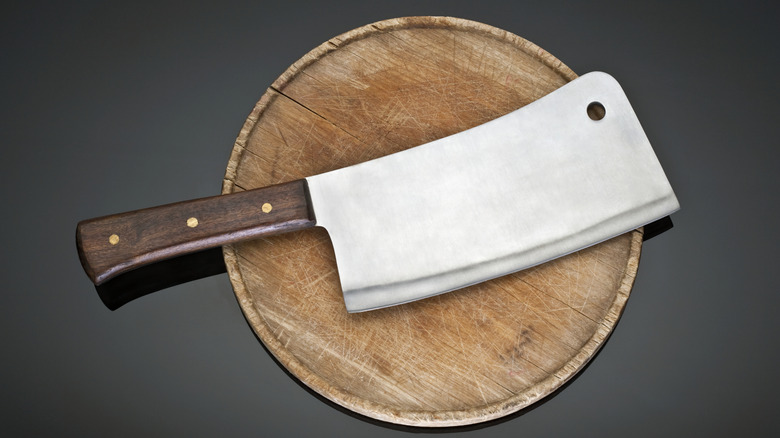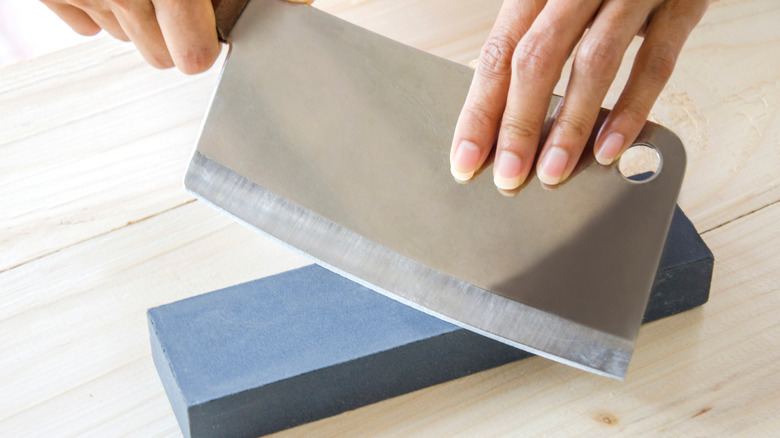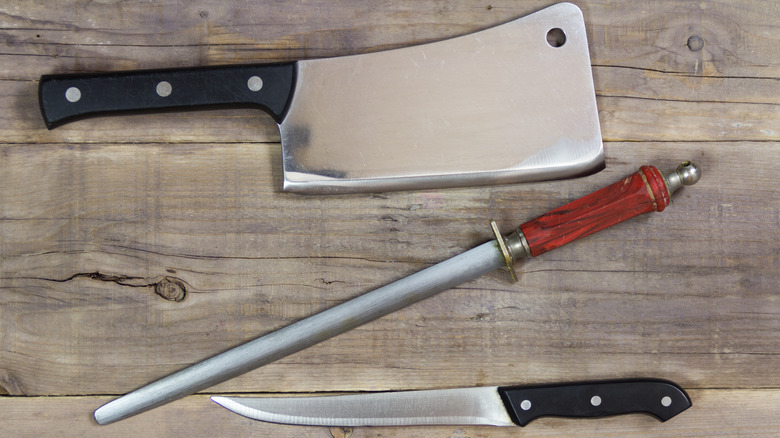How To Sharpen Your Cleaver Knife To Give It A Razor-Sharp Edge
We may receive a commission on purchases made from links.
Using a dull cleaver to hack through meat or slice into a watermelon is a struggle that no one should endure. It's frustrating, inefficient, and even unsafe. Instead of experiencing smooth and precise cuts, you'll find yourself sawing and grunting through tasks that should be quick and effortless. A dull blade doesn't just slow you down; it actually removes the joy out of cooking and turns a simple meal prep into a complicated process.
But you don't need to suck it up as simple kitchen tasks transform into full-blown workouts. Sharpening a cleaver knife is just as simple as using a whetstone (also called a sharpening stone), a tool you need for ultra sharp kitchen knives at home since it can restore a dull blade in no time. This handy and accessible device can breathe life back into a dull blade with just a little effort and the right technique. You don't even need professional skills or other fancy equipment anymore to restore your blade.
Remember that a sharp blade not only makes kitchen tasks more efficient — it's also far safer compared to a dull cleaver that will most likely slip and put your fingers at risk with every forceful push. By following a simple sharpening routine, you'll ensure that your cleaver cuts smoothly, allowing you to cook with the confidence that you will keep all your fingers intact!
Step-by-step guide to sharpening your cleaver with a whetstone
The process of sharpening your cleaver knife is straightforward and really doesn't need highly technical knowledge — just one of the many reasons to consider buying a sharpening stone. You begin by soaking your whetstone in water for 10 to 20 minutes. This step is important since it keeps the whetstone lubricated and prevents metal shavings from clogging its surface. Then, place the stone on a surface lined with a damp towel or a silicone mat to keep it stable while you work. To get consistent results and ensure safety, it's vital that you don't skip this part.
The next step is to find the proper sharpening angle for your cleaver. Most cleavers are best sharpened at an angle of 25 to 30 degrees. Once in the right position, proceed to press the blade at this angle against the coarse side of the whetstone while holding the cleaver handle firmly. Start at the heel of the blade and glide across the stone in a sweeping motion towards the tip. Make sure to maintain steady pressure and that the entire edge makes contact with the whetstone. Repeat this 10 to 15 times before flipping the blade and working on the other side so both edges are evenly sharpened.
You can then turn the whetstone to its finer grit side and do the same process. Doing this will polish the edge and remove any remaining burrs or loose metal bits. But don't forget to rinse the blade from time to time to check your progress and clean away any debris. Once satisfied, it's time to clean the cleaver with soap and water before drying it. You can choose to test its sharpness by slicing through paper or even a soft vegetable like a tomato.
What to do if you don't have a whetstone
A whetstone is the go-to tool for sharpening since you probably have it lying around the house already. Don't worry if you don't have one, though, as you can easily purchase something like the POWERTEC Sharpening Stone or the KEENBEST whetstone. But if buying one is not in your plans or budget, there are other whetstone alternatives you can use to sharpen your cleaver. You can use a honing rod or a pull-through sharpener, which you may also have in your kitchen, but these may not offer the same precision that a whetstone can provide.
So, it would still be nice to invest in a whetstone. After all, it's cost-effective, gives you control over the process, and works for all types of knives, not just cleavers. Plus, there are also some possible dangers of not using the proper tools to sharpen your knives. With these methods in your arsenal, you'll never have to deal with a dull cleaver again!


